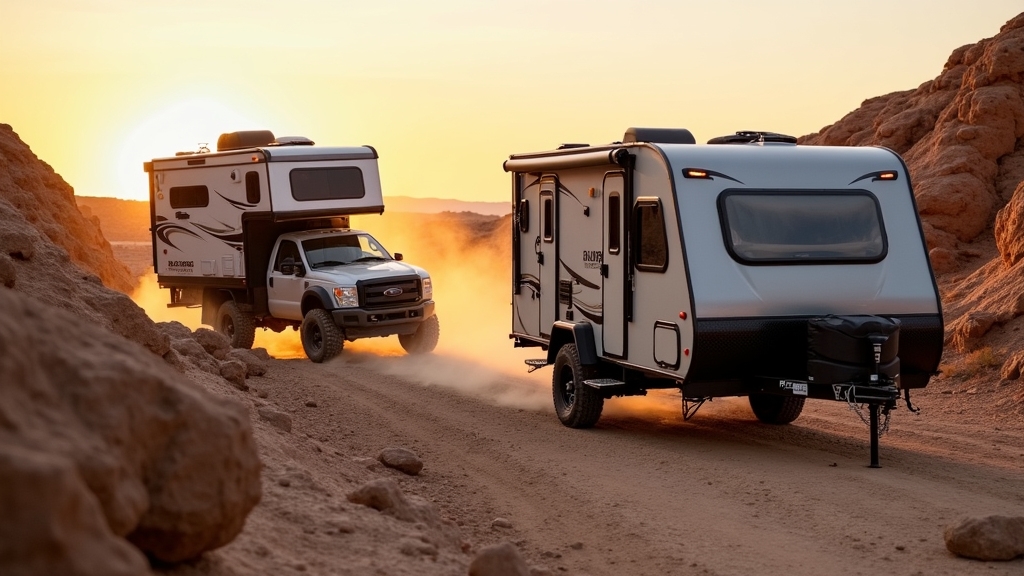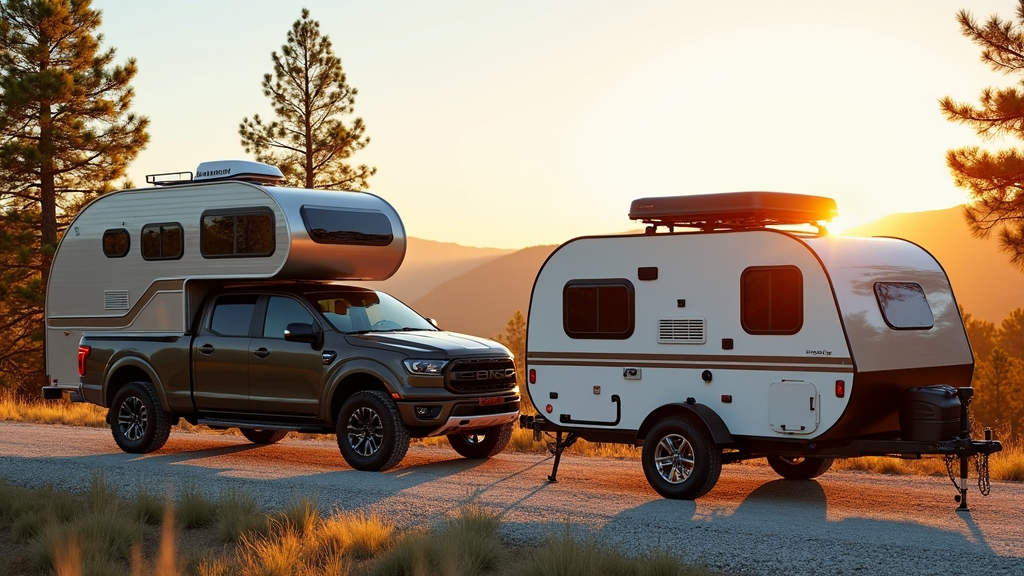If you prioritize off-road access and quick versatility, a slide-in camper fits your truck bed, offering lighter weight and superior maneuverability on rugged trails. Travel trailers give you more interior space, higher ceilings, and separate rooms, better for longer stays and comfort but require larger tow vehicles and careful handling.
Slide-ins detach fast for daily use, while travel trailers demand more setup time. Understanding these trade-offs helps you match the right rig to your adventure style and needs.
Key Takeaways
- Slide-in campers offer superior off-road access and quick detachment, ideal for rugged terrains and spontaneous trips.
- Travel trailers provide larger living space, separate rooms, and better interior comfort for extended stays.
- Slide-ins are lighter and improve vehicle maneuverability, while travel trailers require larger tow vehicles and affect fuel efficiency.
- Slide-in campers have simpler maintenance and faster setup, whereas travel trailers need more upkeep and longer hitching time.
- Travel trailers suit users needing spacious, long-term camping; slide-ins fit those prioritizing flexibility and multi-use vehicle functionality.
Slide-In Camper vs Travel Trailer: Key Features at a Glance
| Feature | Slide in Camper | Travel Trailer |
|---|---|---|
| Weight Range | 1,500-3,500 lbs | 1,200-9,000 lbs |
| Setup Time | Quick detachment (minutes) | Longer setup with leveling |
| Off-Road Access | Superior maneuverability on trails | Limited to established roads |
| Interior Space | Compact, multifunctional layout | Larger living areas with separate rooms |
| Fuel Economy | Better MPG (11-14.5 MPG) | Reduced efficiency (8-12 MPG) |
| Towing Requirements | Uses truck payload capacity | Requires proper tow vehicle and hitch |
| Storage | Integrated, space-efficient | Larger closets and external compartments |
| Price Range | Starting around $11,000 | $20,000-$100,000+ range |
| Vehicle Independence | Detach for daily truck use | Unhitch for independent vehicle use |
| Ceiling Height | Lower (6.5-7 feet) | Higher ceilings for comfort |
| Bathroom Layout | Compact wet/dry bath | Larger separate bathroom areas |
| Maintenance | Lower routine costs, simpler systems | Higher upkeep, complex systems |
| Resale Market | Niche demand, holds value well | Broader market, faster depreciation |
Off-Road Capability and Accessibility Comparison

When you venture off-road, slide-in campers and travel trailers offer distinct advantages and limitations in capability and accessibility.
Slide-in campers provide superior maneuverability in tight trails due to their compact integration with the truck bed, enhancing stability via even weight distribution. Their design also allows for better off-road durability to withstand rugged conditions.
Slide-in campers offer enhanced stability and exceptional maneuverability on tight trails thanks to their compact truck bed design. They’re engineered to tackle rougher terrain but still rely heavily on the vehicle’s ground clearance and traction.
Travel trailers, conversely, face challenges negotiating narrow or uneven paths, as their towing setup limits access to remote spots.
Truck campers excel in ground clearance and adaptability across mud, sand, and steep inclines, granting you more freedom to select campsites off the beaten path.
Additionally, truck campers are designed for off-grid capability, enabling extended stays in remote locations without needing hookups.
However, they demand more complex setup compared to the quick detachment of travel trailers, which offer less off-road capability but greater ease in campsite mobility.
Space, Layout, and Comfort Differences
When you start looking at interior space, you’ll notice that travel trailers really go beyond just the tow vehicle. They offer larger living areas and some pretty flexible layouts compared to slide-in campers, which are limited to the dimensions of the truck bed.
Many travel trailers also feature weatherproof materials that enhance durability and protection. In travel trailers, you often get separate bedrooms and dry bathrooms, making things a bit more comfortable and private.
Slide-in campers, on the other hand, tend to combine sleeping and living spaces, and they usually have compact wet-bathrooms. Their design also makes them highly compact and easy to store, which is ideal for those with limited space at home.
This difference in design really affects your comfort level. With a trailer, you get more privacy and amenities, while slide-ins are all about that mobility but with a more constrained footprint.
Interior Space Comparison
Although slide-in campers maximize the truck bed footprint, their interior space remains notably more compact than that of travel trailers. Travel trailers benefit from wider and longer independent chassis. Their larger frames also allow for the use of higher ply rating tires, which support increased weight and enhance towing safety.
You’ll find slide-ins constrained by the truck bed dimensions, resulting in multifunctional, compact layouts combining kitchen, dining, and living areas with lower ceiling heights (around 6.5–7 feet). They often have lower interior height compared to other camper styles, which impacts overall comfort.
Travel trailers, by contrast, offer distinctly separated rooms with higher ceilings, enhancing standing comfort and spatial separation.
Storage in slide-ins is cleverly integrated but limited, whereas travel trailers provide larger closets, pantries, and external compartments. Even double slide-out campers increase room slightly but don’t match travel trailers’ expansive interiors.
Bathroom and Sleeping Layout
Because space constraints heavily influence design, slide-in campers feature compact bathroom and sleeping layouts that prioritize multifunctionality and efficiency. AGM batteries are often chosen in RVs for their maintenance-free nature and long lifespan, adding convenience during travel.
In contrast, travel trailers leverage their larger footprint to provide more spacious, distinct areas enhancing comfort and privacy. You’ll find slide-in bathrooms often combine shower and toilet in a wet bath, whereas travel trailers offer separate fixtures with greater legroom and ventilation.
Many slide-in campers offer a variety of bathroom types including wet or dry baths to suit different user preferences. Sleeping areas in slide-ins maximize space with over-cab beds and convertible furniture, while travel trailers provide multiple dedicated bedrooms with larger windows and storage.
| Feature | Slide-in Camper | Travel Trailer |
|---|---|---|
| Bathroom Size | Compact wet/dry bath (~30-53” width) | Larger baths (25-35 sq ft), separate areas |
| Sleeping Layout | Over-cab queen beds, multifunctional | Master bedrooms, bunk beds, privacy |
| Comfort & Privacy | Minimal separation, cassette toilets | Full doors, standard RV toilets, ventilation |
Weight and Towing Considerations
When you’re weighing your options between weight and towing, slide-in campers have a bit of an edge. They mesh well with your truck’s chassis, which can help cut down on fuel consumption.
On the flip side, travel trailers can really add to the drag, meaning you’ll need a more powerful tow vehicle to handle them. Travel trailers typically have an average weight ranging from 1,200 to 3,900 lbs depending on their size and design. Choosing the right trailer also means considering the load capacity of your tires to ensure safe transport.
Another thing to keep in mind is maneuverability. Slide-ins let you take advantage of your truck’s turning radius, making them easier to handle in tight spots.
Trailers, on the other hand, can be a challenge, especially when it comes to reversing or navigating narrow roads. So, it’s definitely worth considering your comfort level with handling either option.
And don’t forget about your vehicle’s specs! Knowing your payload and towing limits is crucial. It ensures you’re operating safely and getting the best performance out of your setup, no matter which route you choose.
Fuel Efficiency Impact
Since fuel efficiency directly influences your overall travel costs and environmental impact, understanding how weight and towing affect mileage is essential when choosing between a slide-in camper and a travel trailer.
Travel trailers, often weighing from 1,000 to over 14,000 pounds, reduce gas mileage by 30-40%, typically yielding 8-12 MPG with a 4WD truck. This reduction aligns with the typical towing MPG drop experienced when pulling heavy loads. Selecting equipment with durable materials can help minimize maintenance and improve overall efficiency.
In contrast, slide-in campers, mounted on your truck bed, generally cause less aerodynamic drag and can preserve better fuel economy.
Consider these factors:
- Weight: Heavier trailers considerably drop MPG; slide-in campers are usually lighter.
- Aerodynamics: Mounted campers reduce wind resistance compared to towing bulky trailers.
- Vehicle Impact: Your truck’s towing capacity and engine type also influence fuel consumption.
Driving and Maneuverability
Understanding how weight and towing requirements affect driving and maneuverability helps you make a more informed choice between slide-in campers and travel trailers.
Slide-in campers mount directly onto your truck bed, requiring careful matching with payload capacity. Light models weigh around 400 lbs, while cabover styles exceed 1,000 lbs.
This direct loading impacts rear suspension and stability but maintains your truck’s footprint, preserving maneuverability and off-road capability. Using a reliable tongue weight scale can help ensure your payload stays within safe limits for optimal handling.
Travel trailers, ranging from 2,500 to over 8,000 lbs, attach via bumper hitches and demand appropriate tow ratings, weight distribution, and sway control systems to maintain stability. Because travel trailer weights can vary widely based on size and features, knowing the Gross Vehicle Weight Rating is essential for safe towing.
They add considerable length, complicating turns, backing, and parking, especially in tight or remote areas. Choosing between them hinges on balancing payload limits, handling preferences, and terrain access requirements.
Vehicle and Towing Limits
Although both slide-in campers and travel trailers serve similar purposes, their vehicle and towing limits differ markedly. This affects your choice based on weight capacities and towing capabilities.
Slide-in campers typically weigh between 1,500 and 3,500 pounds and require a pickup truck with adequate bed size and axle load limits. It is important to account for tongue/hitch weight as this downward force impacts towing balance and safety.
In contrast, travel trailers can range from 1,200 to 9,000 pounds. They’re often towed by larger SUVs or trucks equipped with proper hitch systems and braking upgrades.
You must also consider payload from passengers and cargo to avoid overloading. Key considerations include:
- Ensuring your vehicle’s towing capacity matches the camper’s Gross Vehicle Weight Rating (GVWR).
- Maintaining proper weight distribution and center of gravity for stability.
- Verifying that the tow package and suspension meet the trailer’s demands.
Versatility and Mobility Advantages
When you choose a slide-in camper, you gain significant versatility and mobility compared to travel trailers.
Sitting flush with your truck bed, slide-in campers offer a lower height profile, improving maneuverability on narrow or low-clearance roads. Maintaining the camper’s water system properly ensures safe and clean water for your travels.
Slide-in campers sit flush with your truck bed, lowering height and boosting ease on tight, low-clearance routes.
Their lighter weight reduces strain on your truck, enhancing fuel efficiency and driving ease.
Unlike travel trailers, you can detach the camper and use your truck independently, increasing vehicle utility.
The integrated design leverages your truck’s 4×4 capabilities, granting access to rough terrains that trailers often can’t reach.
Compact dimensions simplify parking and orchestrating tight campsites or urban environments.
Additionally, slide-in campers maintain some truck bed space, allowing you to transport extra gear.
Moreover, the ability to quickly park and level the camper means minimal setup and teardown time, making them ideal for frequent travelers quick setup.
These factors collectively provide a more versatile and mobile solution than traditional travel trailers.
Setup and Leveling Requirements
Since proper setup and leveling directly impact your comfort and appliance functionality, you need to approach this step with precision whether you’re using a slide-in camper or a travel trailer.
Travel trailers rely heavily on the tongue jack for front-to-back leveling, while slide-in campers depend on vehicle tire positioning and blocks. It is important to start from a relatively level position using a bubble level to make the process easier and safer. Using strain relief ends can help maintain secure connections and prevent damage during setup.
Both require side-to-side leveling using blocks or ramps, ensuring appliance efficiency and safety.
Key considerations include:
- Use bubble levels on floors or exterior corners to measure tilt accurately.
- Place leveling blocks under tires on the low side; never use stabilizer jacks for lifting.
- Secure tires with wheel chocks and stabilize the rig post-leveling to prevent rollaway and maintain structural integrity.
This methodical approach ensures ideal appliance operation and a stable, comfortable setup.
Cost Factors and Maintenance Needs
Understanding the cost factors and maintenance needs is essential when choosing between a slide-in camper and a travel trailer, as each option presents distinct financial commitments and upkeep demands.
Slide-ins generally start cheaper, around $11,000, but require a truck, adding to overall cost if you don’t already own one. Proper tire care, including regular use of a tire inflator, can help extend the lifespan of your slide-in’s tires.
Slide-in campers cost less upfront but need a truck, increasing total expenses if you don’t own one.
Travel trailers span a wider price range, from under $20,000 to over $100,000, without needing a tow vehicle. Additionally, travel trailers tend to have lower maintenance needs compared to motorhomes due to their simpler mechanical systems.
Maintenance-wise, slide-ins have fewer mechanical systems and simpler construction, leading to lower routine and repair costs.
In contrast, travel trailers’ complex plumbing and electrical systems increase upkeep demands. Insurance and registration often cost less for slide-ins, typically covered under the truck’s policy.
However, travel trailers depreciate faster but enjoy broader resale markets, whereas slide-ins hold value better if well maintained but face niche demand.
Ideal Use Cases for Slide-In Campers
Although slide-in campers offer a compact footprint, they deliver remarkable mobility and versatility that suit users needing quick shifts between camping and daily driving.
You can remove the camper in minutes, restoring your truck bed for hauling non-camping gear like tools or lumber, maintaining your truck’s full utility.
Their compact design also enables access to rough terrain inaccessible to larger trailers, ideal for backcountry excursions.
Consider if you:
- Need rapid setup and teardown for spontaneous trips or daily errands
- Prefer a multi-vehicle recreational lifestyle, towing boats or ATVs independently
- Value space-efficient living with built-in furniture and elevated storage beneath the bed
Additionally, slide-in campers provide four-season insulation and integrated power systems, supporting comfortable use in diverse climates.
Ideal Use Cases for Travel Trailers
While slide-in campers excel in mobility and quick setup for active lifestyles, travel trailers cater to different priorities, especially when space, comfort, and extended use come into play.
If you plan frequent family vacations or extended trips, travel trailers offer versatile floorplans suited to varying group sizes, providing more living space than campers.
Destination trailers serve well for seasonal or long-term stays, featuring residential comforts at a lower cost than second homes. The RV industry supports over 16,000 campgrounds nationwide, providing ample destinations for travel trailer users.
Budget-conscious campers benefit from pop-up trailers, which are lightweight, affordable, and towable by many vehicles without special licenses. Travel trailers also enable you to unhitch and use your tow vehicle independently, enhancing local mobility.
Their wide size range and active resale market make them a practical, flexible choice for diverse camping needs beyond the quick-stop focus of slide-in campers.
Frequently Asked Questions
Can Slide-In Campers Be Used on Any Truck Model?
No, you can’t use slide-in campers on just any truck model.
You have to match the camper size with your truck bed length, usually between 5 and 8 feet.
Also, verify your truck’s payload capacity exceeds the camper’s fully loaded weight.
Mid-size trucks suit smaller campers, while full-size or heavy-duty trucks handle larger, heavier models.
Always check your truck’s door jamb for payload ratings to avoid unsafe overloading and ensure proper fitment and balance.
How Do Slide-In Campers Affect Truck Fuel Economy?
You’ll love how slide-in campers sneakily sabotage your truck’s fuel economy. Expect a drop of about 3-4 MPG due to added weight and aerodynamics.
Typically, you’ll see 11 to 14.5 MPG with these campers, which is actually better than towing a travel trailer that drags you down to 8-13 MPG. Diesel engines handle this load more efficiently, but speeds over 65 mph will still crush your mileage. So, plan accordingly!
Are Travel Trailers Easier to Insure Than Slide-In Campers?
You’ll generally find travel trailers easier to insure than slide-in campers because insurers offer specialized, all-encompassing policies tailored to travel trailers.
These include collision, liability, roadside assistance, and vacation coverage, with evolving usage-based options.
Slide-in campers usually fall under broader, simpler coverage categories, limiting customized options.
However, travel trailers’ higher value and complexity can increase premiums, while slide-in campers benefit from lower costs due to simpler construction and fewer features.
What Is the Typical Lifespan of a Slide-In Camper?
You can generally expect a slide-in camper to last 10 to 15 years with proper upkeep.
Its lifespan hinges on build quality, usage frequency, and storage conditions.
Unlike larger motorhomes, slide-in campers have fewer mechanical parts, reducing failure points.
To maximize longevity, you’ll want to regularly inspect and reseal seams, protect it from moisture and UV exposure, and store it indoors or in shaded areas whenever possible.
Do Travel Trailers Require Special Driving Licenses?
Think of towing a travel trailer like steering a ship through varying waters. You need the right credentials.
Whether you need a special license depends on your state and the trailer’s weight. Most states don’t require one if your trailer is under 26,000 lbs GVWR.
In states like California, towing heavier trailers over 10,000 lbs demands a non-commercial Class A license.
Always check local DMV rules to stay compliant and insured.
Take Action: Finding Your Ideal Slide in Camper or Travel Trailer
When choosing between a slide-in camper and a travel trailer, consider your towing capacity, off-road needs, and desired comfort. Slide-in campers offer superior mobility and quicker setup, ideal for rugged terrain.
Travel trailers provide more living space and layout options. Though weighing your vehicle’s limits is vital, remember that every ounce affects performance
Ultimately, matching your adventure style with these technical factors ensures efficient, enjoyable travels.



